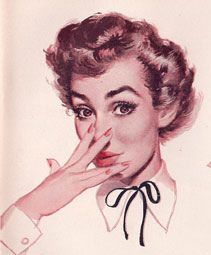April 2019
 While working on a post about the king of travel literature, Patrick Leigh Fermor, I’m reading another author who also ostensibly figures among the ranks of travel literature royalty: Robert Byron. I first read The Road to Oxiana some 15 years ago, with print book in hand containing lots of illustrations. Pictures are indeed worth a thousand words, I come to find out. Over the past few weeks I’ve been working my way through the book on my Kindle without the illustrations, since that miracle of modern technology still can’t reproduce the happy integration of text and image that a print book delivers effortlessly. (Oops, does that sound Luddite?) This state of affairs puts all the burden on the text itself. The results are not fortunate. I discover that without the images a completely different sense of Byron as author emerges and we are not amused. Not one bit.
While working on a post about the king of travel literature, Patrick Leigh Fermor, I’m reading another author who also ostensibly figures among the ranks of travel literature royalty: Robert Byron. I first read The Road to Oxiana some 15 years ago, with print book in hand containing lots of illustrations. Pictures are indeed worth a thousand words, I come to find out. Over the past few weeks I’ve been working my way through the book on my Kindle without the illustrations, since that miracle of modern technology still can’t reproduce the happy integration of text and image that a print book delivers effortlessly. (Oops, does that sound Luddite?) This state of affairs puts all the burden on the text itself. The results are not fortunate. I discover that without the images a completely different sense of Byron as author emerges and we are not amused. Not one bit.
Let’s imagine for a moment that Byron runs a travel agency and his book is a brochure intended to get our business. If he gave us a business card to tuck into it as a bookmark it would likely read thusly:
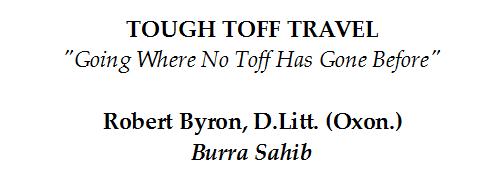
That would represent a piece of truth in advertising. Byron is tough: his stiff upper lip cannot be bent by any force of nature or any misfortune in human experience. He’s intrepid: he ventures into areas of the world where anyone with an ounce of sense, to say nothing of angels, would fear to tread. He’s a paragon of manly adventure: Nature assaults him with an interminable onslaught of obstacles he overcomes in a few lines or before which he retreats bloodied but unbowed. He describes the officials he engages with the dismissive condescension the British Raj honed to perfection. He opines with the voice of expert knowledge on Islamic architecture after pushing cars out of mudpits or driving down mountain roads with sheer dropoffs that would make Indiana Jones soil his britches. Oh yes, he’s got it all, does our Robert. Now there was a toff to reckon with. They don’t make ’em like that anymore.
If the truth be told, however, my latest reading of the book without benefit of pictures brought me quickly to the realization that his travels seem more madness than service to either adventure or art history. If, through misfortune greater than any Byron met on the road to Oxiana, I were forced to undertake a journey like his, my immediate response would be: “Just shoot me. And for God’s sake be quick about it.”
It astounds me that Byron should be classed in the same category of peerless travel writer that Patrick Leigh Fermor occupies. The Road to Oxiana is written as a travel diary, not a through-composed narrative like Leigh Fermor’s A Time of Gifts. Its style is often telegraphic. Its tone is often brusque. The cause for this abruptness is left undisclosed, whether it be because Byron is too butch to wax flowery with words or because he lacks the sensibility to spawn effulgences like those that shoot off Leigh Fermor’s pages like a Roman candle. As I consider Leigh Fermor’s books on his travels as a teenager across the Europe that once was and is no more I find myself reaching into the realm of fantasy to find an apt simile: he’s like Tolkien’s Tom Bombadil, hale and hearty and singing as he strides. Byron’s province, on the other hand, is Mordor. He resembles some diehard from Gondor picking his way across blasted landscapes with Orcs lurking at every turn. There’s nothing of the jaunty, chatty fellow ambling along in the sunshine through the Shire, stopping at some cheerful inn for elevenses.
Having Byron’s text without the illustrations has proved to be dealbreaking. The public face and high reputation crumble before the stark reality of the person the text by itself reveals. It turns out that the pictures hold up the reputation, not the text. I’m about two-thirds of the way through the book and find myself quite grumpy with our hero as he bashes his way through Afghanistan. I’ve been appalled at his recountings of time spent with fellow countrymen in Iran. The recountings are self-satisfied ditherings about privilege and the parties described reek of Raj amateur drama. His descriptions of architecture I know about from other sources strike me as cursory and uninspired. I find myself coming not to trust his powers of observation or understanding concerning the buildings he inspects and more often than not dismisses as unworthy of serious contemplation. In short, he has become for me an imperial phenomenon requiring analysis and deconstruction rather than an unusual individual whose steps I follow eagerly.
Oops. Another icon bites the dust.
I should have seen it coming. It’s difficult to remember what my thoughts were on first reading the book lo these many years ago, but I’m certain the novelty of the area under discussion would have made a strong impression since I knew nothing about it at the time. Having been dragged kicking and screaming through far more news about Afghanistan over the past 15 years than I would wish (let’s not think about the Buddhas of Bamyan), it’s no wonder that Byron’s description of the country strikes me now as irrelevant. The world he strongarmed his way through has long since disappeared, submerged under decades of violence that makes the place radioactive. In this day and age Byron would find himself summarily booted out of the country, assuming he managed to get into it in the first place. I also doubt he’d find it quite as easy to deal with the Taliban as he found it to boss around the local officials he describes in imperial fashion as silly creatures to be bent to his will. That party has been over for a long time.
What I’m left with, then, is an anachronism who did a spot of writing. Is it good writing? Compared to Leigh Fermor’s, no, not particularly good. Once in a while it rises to the same rhapsodic level that appears to be Leigh Fermor’s native habitat, but with Byron it’s entirely episodic, like getting drunk at a party only to wake up the next morning with the cold light of dawn streaming in through the windows. Then it’s back to Etonian understatement and telegraphic sentences that give just the facts, ma’am, just the facts. Those facts are never happy ones, either. Some plan will have gone to ground, some obstacle will have raised its Gorgon head or some building will have proved to be a crashing disappointment. Such is life for our heroic English Imperial Traveller.
So, let’s upack him and see what bits and bobs are stuck together to yield this paragon of the travel narrative genre. A good place to start is with the art expert bit. It has a few problems.
As a point of comparison I’d like to call attention to a fantastic program by Waldemar Januszczak entitled “Paradise Found,” a broad-ranging look at Islamic architecture that includes some of the very buildings Byron inspects on his journey. You can watch the entire program on YouTube here. I always learn a lot from Januszczak’s programs and find his love of the subject infectious. His series of programs on Impressionism is especially insightful and changed in important ways the understanding I had of that body of art. Januszczak is a real expert. He knows his subject matter inside and out, backward and forward. What does Byron bring to the table?
Byron brings the same toff resume you find in many other people of his day and age. If you went to Eton and Oxford (even if you got sent down as Byron did) you apparently became qualified to hold forth magisterially on any topic that took your fancy. Others of his ilk took up the same banner — I’ve written about one of them, Sacheverell Sitwell, who also wrote (boring) travel books in addition to (questionable at best) art history and (wannabe) art criticism. Some people may lament the tendency toward professional compartmentalization that has become a hallmark of our own day. I for one find nothing objectionable about it as a consumer of its end results. When it comes to writing books on art history I’d much rather have an expert with full academic credentials behind the pen than a toff who’s read this or that at Oxford and ran aground on the late-night drinking and whoring (the primary focus of attention) before he got tossed out of the place. Byron’s qualifications are those of class, not of expertise.
He was expelled from Merton College, Oxford for his “hedonistic and rebellious manner” (from his Wikipedia page here). While at Merton he was a member of the Hypocrites’ Club. What’s that, you ask? There’s a Wikipedia page (here) to enlighten us:
The Hypocrites Club was founded in 1921 by John Davies Knatchbull Lloyd, nicknamed the “Widow” since he used the shaving lotion “The Widow Lloyd’s Euxesis”. Wanting to avoid dining in hall, Lloyd and his friends got together to raise the money necessary to rent two large rooms and a kitchen over a bicycle shop, formerly a medieval house, at 31 St Aldate’s (other source said 34 or 131). The rooms were reached through a narrow staircase. They also paid for the part-time services of a cook and a servant-cum-barman. After Evelyn Waugh was introduced to the club by Terence Lucy Greenidge, many of his contemporary fellow students followed soon and the club started to change. From a place where to discuss philosophy it became a place to drink and party. As Waugh remembered later it was a “process of invasion and occupation by a group of wanton Etonians who brought it to speedy dissolution”. Waugh’s excess drinking life habit started with the club, “It was at the university that I took to drink, discovering in a crude way the contrasting pleasures of intoxication and discrimination. On the two, for many years, I preferred the former. A servant at the club would say: “They call themselves an artists’ club but all they draw is corks!”
Byron was a member of the gay set of the Club. Rather than a toff version of Indiana Jones, he had quite a different persona at Oxford:
Some of the members of the club, like Brian Howard were gay, but most were not. But in any case there was a notice on the wall saying “Gentlemen may prance but not dance.” At the time undergraduate students were forbidden to drink in pubs and homosexuality was illegal, therefore clubs like the Hypocrites’ were places to do both in a safe environment. Waugh would remember that the club became “notorious not only for drunkenness but for flamboyance of dress and manner which was in some cases patently homosexual”. The “gay set” of the Hypocrites’ Club listed Arden Hilliard, Hugh Lygon, Harold Acton, Mark Ogilvie-Grant, John “The Widow” Lloyd, Robert Byron, and Gavin Henderson. …
Robert Byron, who was the resident entertainer singing Victorian music hall, joined because it provided him a haven for like-minded “aesthetes.”
Fancy that. You only have to read E. M. Forster’s Maurice to learn what you need to know about that story, wink-wink-nod-nod. Given Byron’s later life it might seem he left behind him the things of wayward youth, but not so. His sisterhood was dyed in the wool. In typical English fashion, the love of his life was not gay so things queued up for yet another tragedy of unrequited devotion (pic follows, Byron on left):
Byron’s great, though unreciprocated, passion was for Desmond Parsons, younger brother of the 6th Earl of Rosse, who was regarded as one of the most magnetic men of his generation. They lived together in Peking, in 1935, where Desmond developed Hodgkin’s Disease, of which he died in Zurich, in 1937, when only 26 years old. Byron was left utterly devastated.
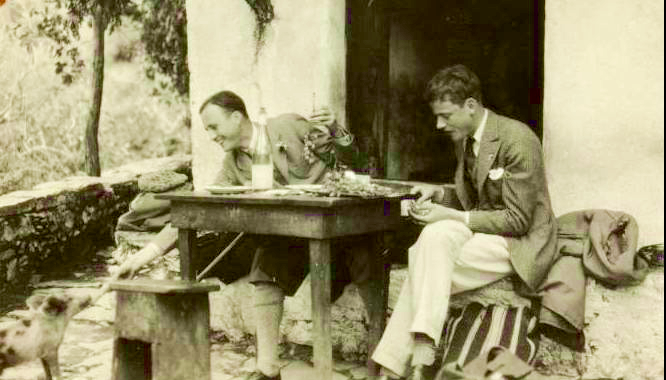
So, with Byron we find ourselves– unsurprisingly — once again with the toff aesthete trope squarely before us. Mummy and Daddy ship you off to Eton and Oxford, you hang out with your chums getting up to all sorts, you read some stuff when you’re not too hung over to open a book, learn how to put a sentence together so you sound intelligent whether that’s the case or not, get sent down for being such a drunken futz and there you have it, you’re ready to hit the wide world and take it by storm. Yeehaw.
After the running about in Iran and Afghanistan came the war, of course, and Byron’s luck ran out in 1941 when his ship was torpedoed in the North Atlantic with all hands lost. Thus ended one of the last brash-dash toff trajectories to hit the history books. The eyebrows shoot up upon reading Evelyn Waugh’s opinion of Byron given in 1948 in a letter to Harold Acton: “It is not yet the time to say so but I greatly disliked Robert in his last years & think he was a dangerous lunatic better off dead.” Goodness me, and that from a fellow member of the Hypocrites’ Club. It’s enough to take the curl out of your perm.
I gave Byron the title “Burra Sahib” on his business card. It’s tongue-in-cheek, of course, but I mean it to be taken seriously because Byron was the classic burra sahib. For those of you not familiar with that term from the British Raj, here’s a definition: “Burra sahib (Hindi: बड़ा साहब baṛā sāhab) “big man” or important person.” You should imagine a man with a clipped moustache, a topee, military jacket and hemmed shorts holding a riding quirt under his arm as he dispenses orders to underlings. He’s as old boy as they get. Sandhurst, obviously, not Oxford, but it’s six of one or a half dozen of another. He’s an imperial fixture that will only survive during the first third of the 20th century, by which point he will show himself as historically obsolete and culturally irrelevant. He will become the butt of comedy skits for years to come. In the minds of people outside England he will continue to be a fixture in their understanding of Englishness despite his having long since disappeared from the lands in which he was bidden good riddance. He is, thankfully, an anachronism. May his like never darken our doorsteps again.
And thus is Byron. Byron was a variant of the burra sahib type — no topee, no quirt under the arm, instead he was the D.Litt. (Oxon.) variety. It’s all about the architecture, dontcha know. These curious brown people one must deal with on the trip are so tiresome, really, but it’s all about the architecture at the end of the day. Only one is not an architect. One is not even an art historian. One is simply a toff who got tossed out of university and now runs about the world looking at things and making comments. Byron remains faithful to the burra sahib impulse throughout, since once to that manor born there’s no leaving it. It’s like being in the Mafia in that regard, come to think of it …
Here’s an example I’ve come across in this reading of burra sahib talk:
At Kirmanshah the chaffeur gave way to temperament. He did not wish to spend the night at Hamadan; he wished to sleep at Kazvin. Why, he could not say — and I doubt if he knew; he was like a child who wants one doll rather than another. To stop the argument, which had begun to involve the whole staff of the hotel, I went off to Tak-i-Bostan for the morning. It thus became impossible for us to go further than Hamadan that day.
These silly brown people, they’re like children, really. One never knows what nonsense they’ll foment. One more example and I’ll call it good:
Abbas and the muleteers were too chloroformed with opium this morning to start punctually. When we complained, they laughed in our faces. In fact their manners are vile; and in a country which sets a premium on manners, there is no need to be good-humoured about it. This evening, therefore, when they began to settle down in our room, I shooed them out, hubble-bubble, samovar, and all. At this Christopher was perturbed, saying it was against custom, and illustrating his point by a story of how once, when he was staying with a Bahktiari chief and wished to say something in private, he positively appalled his host by suggesting that the servants should be sent out of the room. I answered that I also have customs, and one of them is not to be inconvenienced by the pipe or presence of muleteers in my own employ.
I don’t find the name of Noel Coward in Byron’s mention of reading — Gibbon and Proust, yes, both of which sound infinitely less probable than Coward, but there it is. A pity really, since they shared so much, as this passage from Private Lives reveals:
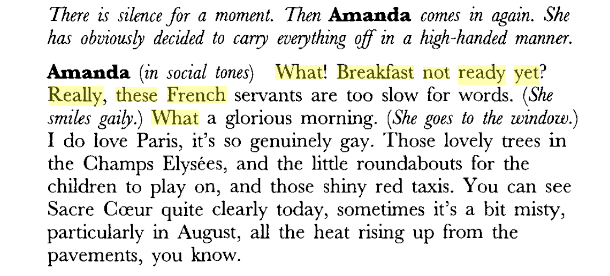
Ah, these burra sahibs and memsahibs … such a way with words!
I needn’t multiply examples, it’s quite clear that we’re dealing with a superior presence operating on an inferior one. You can’t have burra sahibs without that dynamic locked and loaded. It’s all part and parcel of the Imperial English shtick, isn’t it. The Empire on which the sun etc. etc.
The most predominant feature of Byron’s writing in The Road to Oxiana has to do with the stiff-upper-lipness. Ian Hislop did a fantastic two-part BBC program on the phenomenon I found extremely enlightening. We all think of the stiff upper lip as part of Englishness, of course, but Hislop examined it in great detail with careful attention to its historical development. One of my favorite stories from the earlier phases of the phenomenon is the anecdote from the Battle of Waterloo in which Lord Uxbridge, sustaining a direct hit from incoming fire, exclaims to Lord Wellington, “By God, sir, I’ve lost my leg!” To which Lord Wellington replies: “By God, sir, so you have!”
Byron belongs to its latter phase, of course, but stylistically he remains faithful to the earlier 19th century version of the beast. As I read The Road to Oxiana this time the litany of mishaps, misfortunes and inconveniences is so unremitting and so gruelling that it seems Byron struck out determined to find difficulties in order to have something to write about. One example comes to mind as typical of the general course of things. Byron was in Teheran, stuck because transport failed to be as easy to arrange as he hoped. He had the bright idea of buying a used car to get him on his way to Afghanistan. The process of getting the necessary documentation took a further four days of agonizing muddle between several offices, described in agonizing detail over several pages. Finally he gets underway and one hopes the debacle is over, then comes the next chapter:
The back axle has broken, sixty miles from Teheran.
“To Khorasan! To Khorasan!” shouted the policeman at the city gate. I felt a wonderful exhilaration as we chugged through the Elburz defiles. Up or down, the engine was always in bottom gear; only this could save us from being precipitated, backwards or forwards as the case might be, over the last or next hairpin bend. Seven chanting peasants pushed the car uphill to a shed in this village. It is a total loss. But I won’t go back to Teheran.
Right-o, old boy, one soldiers on, doesn’t one. In for a penny, in for a pound. That sort of thing.
The book is an unremitting series of such debacles punctuated with descriptions of buildings that end with remarkably few exceptions in disappointment. One does not feel oneself edified. A picture would be much better than the thousand words supplied. With the picture one has the possibility of seeing the building for the thing in itself, without the faux-expert lensing Byron gratuitously provides. I’ve done enough foreign travel myself to know that surprising and moving things can turn up in the most unlikely places. But in order for such discoveries to happen one must be open to the experience of them. Byron is a list-maker from hell, chasing down things he’s found in somebody else’s work. His book in its entirety is a recounting of the horrors of movement through the disappointing space containing the often disappointing structures on his list. This approach is diametrically the opposite of Leigh Fermor’s, particularly in the books describing his hike across Europe as a young man. He meets everything with the freshness of youth and its embrace of new experience. As a result he’s often surprised by delight. Not our boy Robert, however. Quite the contrary.
My grumpiness with Byron made me feel guilty so I decided to read another of his works, First Russia, Then Tibet, which also figures in the canon of great travel writing. It’s through-composed, not in diary format, so I thought in the interest of fairness I should give Byron a shot at weaving a good tale rather than jotting things down at the end of a horrific day after at least one broken axle and a run-in with brigands. In contrast to the case with Islamic architecture in Persia and Afghanistan, I’m on quite solid ground with regard to Russian architecture, having had a passion for it for long years that has led me to read enormous amounts about it. All I have to do is close my eyes and think the word “Bogolyubovo” to have a sharp image of that gorgeous church come before my inner eyes — the Church of the Intercession of the Virgin on the River Neri. Here’s a pic:
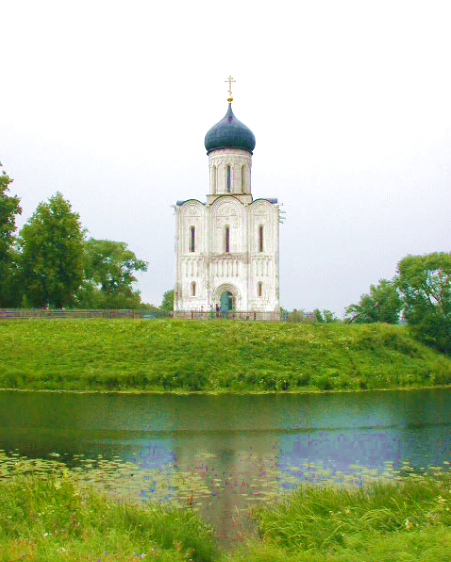
Byron’s Russia trip follows the same pattern as his travels recounted in The Road to Oxiana when there was no real necessity for that similarity. There’s the same slapdash manner, the same laundry list of sights to see and check off, the same pretensions to expertise in art history and aesthetics, the same recounting of physical hardship. Byron appears to have stacked the deck weather-wise by going to the then Soviet Union in the dead of winter. Wouldn’t somebody in their right mind intent on travel in the Soviet Union to inspect architecture do the trip in June rather than January? Of course they would. Russian winters are infamous, as Napoleon found out to his lasting dismay. Odd that Byron didn’t get that memo before heading off to the place when the temperatures were low enough to freeze extremities in the span of fifteen minutes.
The Soviet Union seems a dicey choice to carry on as a burra sahib, but that’s exactly what Byron does, which I suppose shouldn’t surprise. Once a burra sahib, the habit hardens quickly and holds like concrete. Byron eventually lands in Yaroslavl, a wonderful historic town of Old Russia. Even here it’s a stage for our posho Indiana Jones to carry on imperially:
… To the Spassky monastery we went, a white-walled enclosure guarded by massive square towers with wooden conical roofs. The courtyard was also in ruins; for there was a lot of fighting at Yaroslavl in the Civil War. its single inhabitant asserted with glee that the Museum Chancellory was elsewhere. At the same time a sentry tried to confiscate my camera. So I gave the driver a prod and we drove off at a gallop. Suddenly I recognized the real cathedral of St. Elias, having already seen a photograph of it. The Museum Chancellory was opposite. On entering, we were told that a committee meeting was in progress and could not be disturbed. I ventured to suggest that it could be disturbed, and, dragging my guide with me, burst into its room, followed by a protesting janitor. Thereupon the necessary officials placed themselves at my disposal, showed me a number of Slavonic manuscripts and told me how to reach the monuments I was in search of.
What? Frescoes not ready yet? Really, these Russian servants are too slow for words.
And of course, after all the brouhaha, disappointment awaits:
… the cathedral of St. Elias, whose five domes, outer galleries and detached bell-tower with conical roof exhibit the chief characteristics of the Yaroslavl style. This was built in 1647, the domes are green; the outside is covered with plain whitewash. But within, the frescoed walls reveal a jungle of sacred themes in the brightest colours, which are still enclosed in the schematic compartments ordained by the Byzantine Church, and thus represent the last and most fantastic offspring of the Orthodox tradition of Christian art. This was the only interior we had access to. I was glad to have seen it, but had no desire for more, since the interest of the paintings was hagiographical rather than artistic.
Oops, frowny face. And one more thing ticked off the list. It’s so hard to find good art these days.
Byron could get away with such a lapidary assessment of a major architectural monument in the 1930’s because nobody was likely to offer pushback in the comments or take him to task on Twitter. But in this day and age we have the Internet and can see for ourselves both the building described so dismissively and the frescoes Byron gives short shrift. The site “Russia Travel Blog” has a great spread of pics of both the building and the paintings here. Once again, a few pics show themselves to be worth far more than Byron’s less than a thousand words. Here’s just one example:
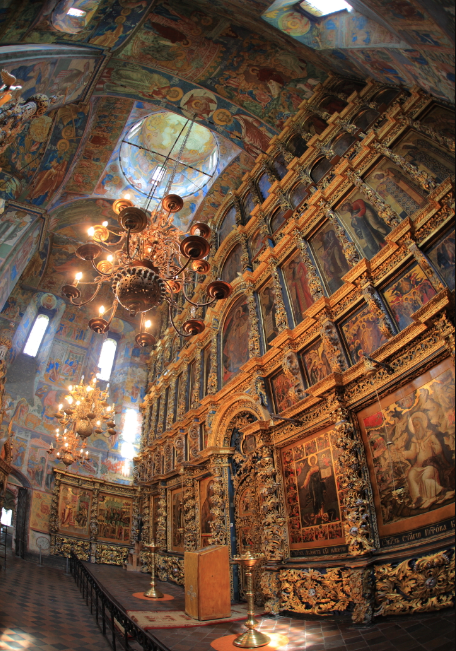
Looks to me like burra sahib speak with forked tongue. I don’t see anything worth dismissing out of hand in any of the images I find of the cathedral’s interior. I think what we have on our hands is a wholly unreliable narrator. Reading along as he describes wonderful architecture in a few short and dull sentences and then trashes the fantastic art they contain quickly set off my alarm bells. Why should I trust this guy? Why should I even pay him any attention? Either he has no eyes to see or he’s not worth the powder and lead to blow him to art criticism smithereens. After struggling through two-thirds of his Russia trip I made my assessment: he’s not worth the powder and lead. What’s more, he’s an insufferable prig.
Just to point out the depth of Byron’s failure to reach legitimate iconic status as a travel writer or an art critic, let’s compare him to Rebecca West on her travels through Macedonia in Black Lamb and Grey Falcon, likewise looking at some frescoes in a monastery:
… On a broad ledge under dripping cliffs, here hung with purple flowers, among wind-swept trees that leaned laterally over the abyss, we found the little monastery. It was minute and in poor repair, but it had kept its frescoes. A bar of sunlight struck through a gap in the wall and lay on the anguished figure of the Virgin Mary lifting Christ down from the Cross, like a finger laid by nature on the corrupt spot which the animal world has contracted by its development of consciousness: its liability to grief. Bitter what consciousness bring us, yet bitter beyond anything the loss of it; that the painter showed us in the figure of Christ, which was typically Serbo-Byzantine. In too many Western pictures Christ looks as if He were wholly dying, and as if He were making an unmanly fuss over it considering his foreknowledge of the Resurrection. But in all these Macedonian frescoes death is shown working on the body that is bound to the spirit of Christ, wringing the breath out of the lungs as a laundress wrings water out of a shirt, taking the power out of the muscles and nerves like a dentist drawing a tooth whose roots drive down through the whole body. There is demonstrated that separateness of the flesh which Proust once noted, in a passage which describes how we think in our youth that our bodies are identical with ourselves, and have the same interests, but discover later in life that they are heartless companions who have been accidentally yoked with us, and who are as likely as not in our extreme sickness or old age to treat us with less mercy than we would have received at the hands of the worst bandits.
That, now, is great travel writing. By reading it I’m given experience of the art described in a way wholly memorable despite my never having laid eyes on the art itself. West provides the reader that sense of fulfillment across all 1,200 pages of her remarkable book. I can’t find it on a single page by Byron.
I feel cheated. Burra Sahib talks big but doesn’t deliver. He’s the sort of person I dread having to sit next to on airplanes. Whoda thunkit, his reputation being what it is.
I should have known what I was up against the minute I identified Byron as a burra sahib. I’ve read enough on the Raj to know the type and that nothing good ever comes from that lot. How miserable to be so fond of things English and to find one’s Anglophile affections abused by someone who belongs in Dubuque, Iowa wearing a MAGA cap and sipping coffee in a McDonalds. Ho-hum …
So, let me sum up Byron as a travel writer by borrowing a phrase from Gilda Radnor’s inimitable Emily Litella: “Never mind.”
